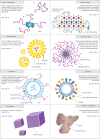Nanotherapeutics in the EU: an overview on current state and future directions
- PMID: 24600222
- PMCID: PMC3933707
- DOI: 10.2147/IJN.S55359
Nanotherapeutics in the EU: an overview on current state and future directions
Abstract
The application of nanotechnology in areas of drug delivery and therapy (ie, nanotherapeutics) is envisioned to have a great impact on public health. The ability of nanotherapeutics to provide targeted drug delivery, improve drug solubility, extend drug half-life, improve a drug's therapeutic index, and reduce a drug's immunogenicity has resulted in the potential to revolutionize the treatment of many diseases. In this paper, we review the liposome-, nanocrystal-, virosome-, polymer therapeutic-, nanoemulsion-, and nanoparticle-based approaches to nanotherapeutics, which represent the most successful and commercialized categories within the field of nanomedicine. We discuss the regulatory pathway and initiatives endeavoring to ensure the safe and timely clinical translation of emerging nanotherapeutics and realization of health care benefits. Emerging trends are expected to confirm that this nano-concept can exert a macro-impact on patient benefits, treatment options, and the EU economy.
Keywords: EU approval procedures; EU marketed products; drug delivery; nanotechnology.
Figures
References
-
- Mura S, Couvreur P. Nanotheranostics for personalized medicine. Adv Drug Deliv Rev. 2012;64(13):1394–1416. - PubMed
-
- Wagner W, Huüsing B, Gaisser S, Bock A. Nanomedicine: drivers for development and possible impacts. Centre ECJR, Studies IfPT, trans: European Commission Joint Research Centre, Institute for Prospective Technological Studies; 2006.
Publication types
MeSH terms
Substances
LinkOut - more resources
Full Text Sources
Other Literature Sources



